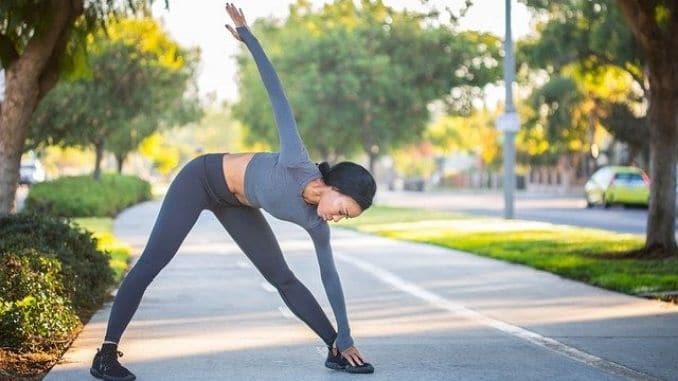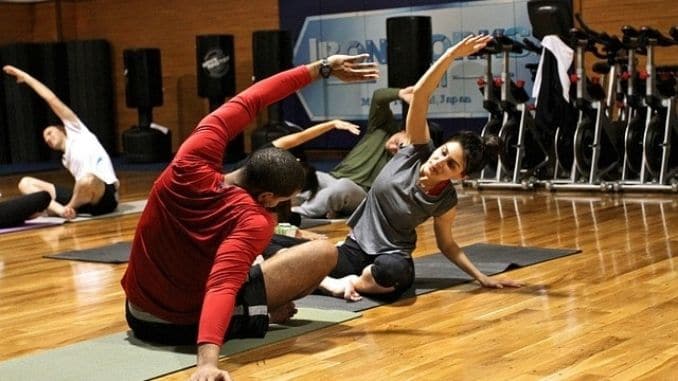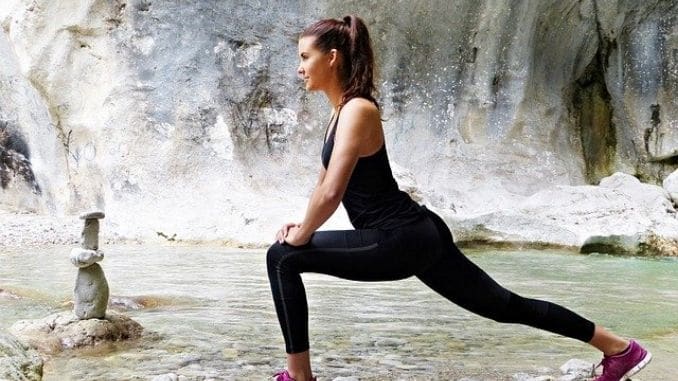
One of our readers recently asked us about a potential link between tight psoas muscles (pronounced SO-as) and the diaphragm. Tight psoas muscles can contribute to postural imbalances and discomfort, potentially affecting breathing patterns by restricting the diaphragm’s full range of motion. This connection might explain some breathing difficulties or discomfort in the abdominal area.
“In the past six months or so, I sometimes find it very hard to fill my lungs. My chest X-ray showed a compressed diaphragm. My chiropractor says my psoas and diaphragm are the cause. It is very uncomfortable. Chiropractor pushed in on my abdomen on both sides of my navel to release the psoas and it helped. Can a tight psoas, due to stress, compress the lung capacity? Can you tell me which exercises I should do daily to affect this area?”
Is it possible these two are connected? Below, we explore the answers to this question and offer some exercises that may help if you, like our reader, are struggling with this area.
What Is the Psoas?
The psoas is the biggest and strongest of the hip flexors — a group of muscles that work to pull the thigh and torso toward each other. It runs from the lower lumbar region in the back through the pelvis to the femur (thigh bone) on either side of the body and is the only muscle that connects your spine to your leg (on either side).
Because of its location deep within the core, it’s difficult to feel the psoas with your hands or to sense where it is. You can see it in action, however, when you lift the upper leg toward the body, and when you lower the leg back down. Common examples of psoas activity occur when you’re walking, running, dancing, climbing stairs, bending, practicing yoga or doing any other activity that requires movement in the upper leg.
Just getting out of bed requires the psoas as it is the primary connector between your torso and your leg. It affects your posture and helps to stabilize your spine and is also working when you rotate the hip, such as when you point your toe out to the side and when you bend the spine to one side or the other.

Is the Psoas Connected to the Diaphragm?
As our reader noted, there is a connection between the psoas and the diaphragm.
The diaphragm is the main muscle that helps control your breathing. Dome-shaped, it separates the chest from the abdomen, sitting just underneath the ribcage. It helps expand the lungs when you’re breathing in and contract them when you’re breathing out. It’s also involved in coughing, vomiting, defecation, and childbirth.
The diaphragm works on an involuntary basis, such as when you’re sleeping, but can also be worked voluntarily, such as when you’re blowing up a balloon or playing an instrument. The diaphragm is also responsible for hiccups, which are involuntary contractions of the diaphragm caused by some sort of irritation, such as may occur when you drink a soda or other carbonated beverage.
The psoas muscles are connected to the diaphragm at each side via two tendons that extend down and link to the spine alongside where the psoas muscles attach. One of these tendons — the medial arcuate — wraps around the top of each psoas. Connective tissues (called “fascia”) also link the psoas muscles with the diaphragm | 404 like fingers interlacing.
Connected as they are, the diaphragm and psoas muscles work together as a unit, affecting not only posture and your ability to walk but respiratory and spinal health as well. When the psoas is supple, healthy and in harmony with the diaphragm, breathing and movement are easy, and the psoas not only helps move your legs but also acts as a pump increasing circulation and connection to the organs.
This unit also works together when you are startled, frightened, stressed or excited. Each of these emotions usually results in the contraction of the psoas that, in turn, can pull on the diaphragm and shorten the breath.
Under optimal conditions, any tightness in the psoas muscles is temporary and disappears when the muscles relax again. If the psoas muscles become chronically tight and shortened, however, they can grow stiff and rigid, pulling on the diaphragm and affecting breathing, perhaps leading to shortness of breath and a feeling of being tense and stressed.
Do I Have Tight Psoas Muscles?
Symptoms of tight psoas muscles may include:
- Lower back pain when sitting or standing
- Pain when climbing stairs
- Knee pain with no apparent cause
- Pain in the buttocks
- Pain in the front of the hip socket
- Radiating pain down the leg
- Sciatica
- Functional leg length discrepancy — a tight psoas can cause the pelvis to rotate forward, creating an internal rotation of the leg on that side. The other leg rotates externally to counter-balance, making the affected leg longer when walking.
- Pain when moving the hips
- Postural problems — short and tight psoas muscles pull the pelvis into an anterior tilt, causing excessive curvature in the lower back and creating a “duck butt” posture
- Constipation — tight psoas muscles impede blood blow and nerve impulses to the interior organs
- Shallow, chest breathing — tight muscles thrust the ribcage forward, causing shallow breathing
What Causes Tight Psoas Muscles?
One of the main causes of tight psoas muscles today is an excess of sitting. With so many of us strapped to the computer for at least part of our jobs — as well as sitting in the car for our commutes, at the tables for meals and on the couch in front of the television — we can shorten and tighten these muscles gradually. Anyone living a mostly sedentary life, even if they’re working out for 30 minutes or more per day, is at risk for tight psoas muscles.
Athletic training that leads to injury or other types of physical trauma can also cause psoas tension, as can overstretch or torn ligaments and other muscle imbalances. Another factor is stress. Anytime you’re stressed out, the psoas muscles tighten. You may not have noticed it, but next time you’re involved in a stressful situation, pay attention to how your body reacts. The psoas muscles, in particular, tend to tense up.
Short-term stress won’t cause a problem, but chronic stress that continues on a low level for weeks or even months can result in symptoms of psoas tightness. When we’re experiencing these types of long-term stressful periods, we “train” the body to keep certain muscles tight, and the psoas muscles are particularly vulnerable. The solution, then, involves not only physical therapy but emotional work as well.
How to Release Tight Psoas Muscles and Breathe More Easily
If you suspect you may be suffering pain, shortness of breath or other issues because of tight psoas muscles, check with your doctor for a diagnosis. The following tips may also help release tightness and ease your discomfort.
1. Get Up More Often
Sitting for extended periods results in tight psoas muscles, so set a timer and get up more often. Every 30 minutes is a good place to start. When the timer goes off, get up and walk around before returning to work.

2. Practice Good Posture
When you are sitting, use good ergonomics. Make sure your hips are slightly higher than your knees. Use a folded towel under your hips if needed. Avoid bucket seats and chairs lacking good lumbar support.
When standing, pull your shoulders back and point your chest up. Keep your weight primarily on the balls of your feet, with the knees slightly bent. Tuck the abdomen in, and let your hands rest easily at your sides.
You can check your posture by standing with your back up against a wall. Your head, shoulder blades, and buttocks should touch the wall while your heels remain about 2 to 4 inches away. Slide your hand behind the curve in your lower back with your palm flat against the wall. You should feel about one-hand’s thickness between the wall and your back.
If there’s too much space, it means you need to tighten your abdominal muscles to flatten the curve in your back. If there’s too little, you need to arch the back a bit more. Take the test once a day, and then try to maintain the correct posture.
3. Hip Extension Psoas Stretch
Kneel on one knee, then lean forward toward the front leg. Don’t allow the knee to pass the toes. Tilt your pelvis back a little to flatten the lower back, then reach the arm on the same side as the back leg up and over, crossing above your head to the other side. You should feel a stretch in the psoas. Hold for 10 to 20 seconds, then repeat on the other side.
4. Bridge With Pelvic Tilt
Lie down on your back with the knees up and arms on the floor. Lift the pelvic region into the air, tucking it under and hold for 5 to 10 seconds, then lower down. Repeat five to 10 times.
5. Constructive Rest
Lie on the floor on your back with your knees bent and feet on the floor hip-width apart. Place the heels a comfortable distance away from the buttocks. Rest your arms over your belly. Stay for 10 to 20 minutes to allow tension to drain from the psoas muscles.

6. Practice Pelvic Awareness
The position of your pelvis when you’re standing can tell you a lot about your psoas muscles. Think of your pelvis as a bowl and imagine it full of milk. Then, stand sideways in front of a mirror and note the position of the pelvis.
You should be able to draw a line from the back to the front that is straight, and your pelvis should be in a position that none of the milk would spill out. If that line tilts downward, your belly pokes out with an exaggerated curve in the lower back, and you can imagine the milk spilling out the front, you are likely to have tight psoas muscles. Use your abdominal muscles to pull your belly in and rotate your pelvis back.
If the line runs upward, your lower back is overly flat, and you can imagine the milk spilling out the back while your pelvis is tilted toward the back of your body, which means the psoas muscles may be overstretched and weak. Talk to your therapist about strengthening exercises.
7. Practice Daily Stress Relief
Stress results in tight psoas muscles, to regularly remind yourself to relax throughout the day. Then make sure you practice at least one stress-relieving activity a day, such as going for a walk in the park, meditation, yoga, tai chi, music therapy, spending time with a pet or something that helps you release tension and feel more supple in your muscles.
For more psoas stretches, make sure to check out Unlock Your Hip Flexors, here!



